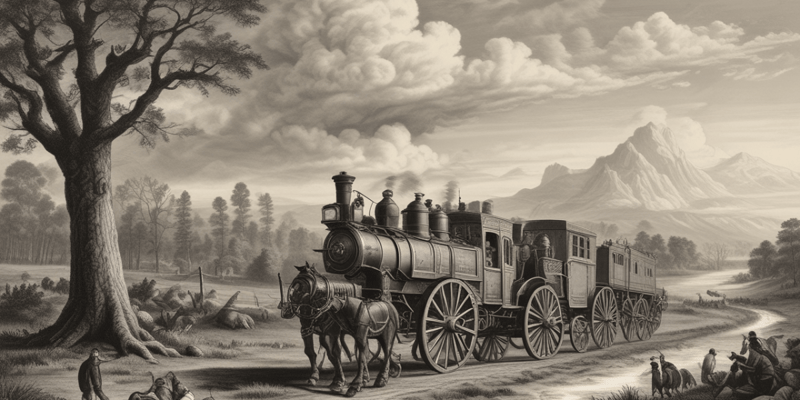Podcast
Questions and Answers
What was the primary source of fuel for the Southern economy?
What was the primary source of fuel for the Southern economy?
What was the main goal of the Western states in their alliance with the Southern states?
What was the main goal of the Western states in their alliance with the Southern states?
What was the main concern of the Northern states regarding the tariffs and land?
What was the main concern of the Northern states regarding the tariffs and land?
What was President Jackson's initial stance on the sectional tensions?
What was President Jackson's initial stance on the sectional tensions?
Signup and view all the answers
What was the outcome of the disagreement over tariffs and land?
What was the outcome of the disagreement over tariffs and land?
Signup and view all the answers
What was the primary occupation of the people in the Western states?
What was the primary occupation of the people in the Western states?
Signup and view all the answers
Who was President Jackson's Vice President?
Who was President Jackson's Vice President?
Signup and view all the answers
What was the main area of disagreement between Jackson and Calhoun?
What was the main area of disagreement between Jackson and Calhoun?
Signup and view all the answers
What was the primary concern of the nullifiers regarding the federal government?
What was the primary concern of the nullifiers regarding the federal government?
Signup and view all the answers
What was the outcome of the Nullification Crisis in 1832?
What was the outcome of the Nullification Crisis in 1832?
Signup and view all the answers
Why did Calhoun resign as Vice President in 1832?
Why did Calhoun resign as Vice President in 1832?
Signup and view all the answers
What was the significance of the institution of slavery in the American South?
What was the significance of the institution of slavery in the American South?
Signup and view all the answers
What was the outcome of the federal government's threat to use military action against South Carolina?
What was the outcome of the federal government's threat to use military action against South Carolina?
Signup and view all the answers
What was the ordinance of nullification passed by South Carolina in 1832?
What was the ordinance of nullification passed by South Carolina in 1832?
Signup and view all the answers
What was the relationship between Jackson and Calhoun before the Nullification Crisis?
What was the relationship between Jackson and Calhoun before the Nullification Crisis?
Signup and view all the answers
Study Notes
Sectional Differences and Tensions
- The US faced sectional tensions due to differing economies in the North, South, and West.
- The North had a heavy industry and capital-based economy, whereas the South had an agricultural economy fueled by slave labor, sharecroppers, and a small but powerful landed gentry.
- The West, like the South, had an economy based on agriculture and raw materials and needed to expand to grow economically.
Western States and Land Expansion
- Western states sought an alliance with Southern states to reduce the cost of government land and lower protective tariffs, which would strengthen their economies.
- However, Northern interests opposed this, seeing protective tariffs as necessary to raise revenue for the government and protect America's young industrial base.
Nullification Crisis
- The nullification crisis centered on a state's right to declare null and void any federal mandate it did not wish to follow.
- This idea was advocated by John C. Calhoun and others who believed states had the right to interpret the Constitution as they saw fit.
- President Jackson strongly opposed nullification, believing it would lead to the disintegration of the union.
Jackson and Calhoun on States Rights
- Jackson and Calhoun had differing views on states' rights, with Calhoun supporting states' rights and Jackson opposing it.
- Jackson stated that if any state were allowed to nullify federal law, there would be no union.
Nullifiers and Tariffs
- The main issue bothering the nullifiers was the federal tariff, which they saw as unfair to their economies.
- They were also concerned that the federal government would soon seek to expand its power and ultimately abolish slavery.
Slavery and Economy
- Slavery was seen as necessary to the economy of the American South, and any talk of abolishing it was unthinkable.
- In South Carolina, where slaves outnumbered whites 2 to 1, the idea of freedom for slaves was seen as a threat to the lives and livelihood of Southern plantation owners.
Ordinance of Nullification
- In November 1832, South Carolina passed an ordinance of nullification, refusing to obey the federal government's tariffs.
- The ordinance also gave the South Carolina legislature the power to raise an army and equip it.
Jackson's Response
- Jackson immediatelyacted, making it clear that he would send troops if necessary and punish any act of treason by any man, legislator, or state.
- Jackson believed that nullification was treason and would not back down.
Compromise and Resolution
- A compromise tariff bill was passed, promising to lower tariffs over a period of ten years.
- The crisis was temporarily calmed, but the issue of nullification and states' rights remained unresolved.
Studying That Suits You
Use AI to generate personalized quizzes and flashcards to suit your learning preferences.
Description
This quiz covers the sectional tensions in the US during Andrew Jackson's administration, comparing the economies of the North, South, and West.




